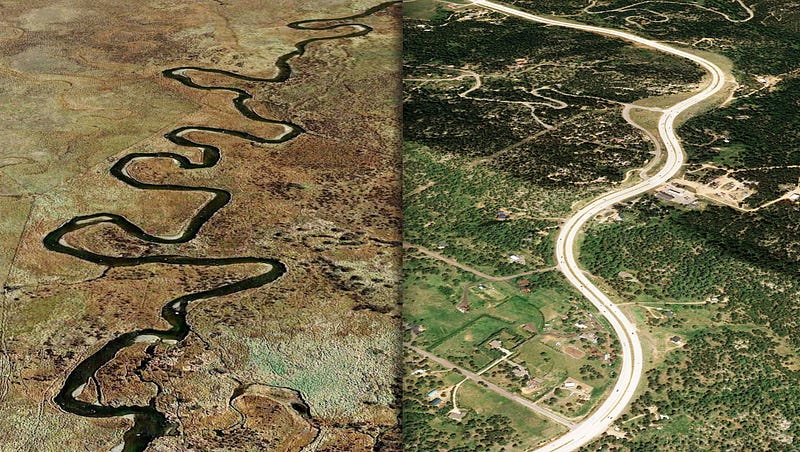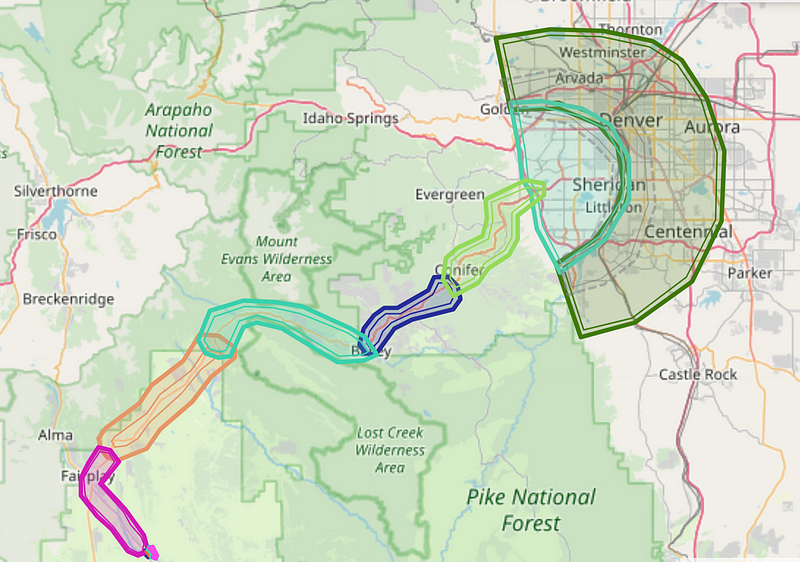
From Here to Where

Most of my work combines musical elements and field recordings, and I often create audio environments that augment the physical landscape. I take a landscape and create an ambient layer of music that changes depending on where the listener is located. Within that ambient layer of music I add field recordings and spoken-voice recordings. Often, I collect voices from people asking them about their feelings or thoughts on certain topics, and then assimilate those voices, cutting them up and splicing them into musical installations.
To experience one of my installations, listeners use a custom smartphone app or website. As you walk through space, you hear a unique version of the piece based on your location and path. I often let participants use the same interface to add recordings of their own in real-time, which gives me even less control over the final product! As a participant, you can, for example, be standing next to a tree and press record and talk about what that tree reminds you of. The recording will be uploaded to a central repository, and the next person who walks by can hear you talking about how the tree reminds you of your grandmother’s house when you were a kid, swinging on a swing beneath her tree.
Read the full conversation with Halsey Burgund and fellow artists Rashin Fahandej and Andrew Demirjian here: Sound That Surrounds
I developed a contributory audio augmented reality platform called Roundware to support these installations. Rather than creating a static, fully-developed piece, I use Roundware to create a framework within which people can contribute and which continues to change over time.
From Here To Where is an audio installation designed to be experienced by people as they travel between Denver and the high plains of the Rockies, where Re/Call, the commissioning entity for this piece, was staging a weekend-long event. I was interested in the transition from the city to the country and, since most participants traveled more or less on the same path, I thought that was an opportunity.
You start in the city, travel through city streets, then the foothills, past a series of plateaus, up into higher elevations, and, finally, over a pass into the vast open space of South Park. The audio experience acts as a complementary emotional journey that brings the listener from the city out into a place that is vastly different, a place dominated by nature.
Depending on whether listeners drive straight through or choose to pause along the route, the piece adjusts and plays a unique version for each trip. I intended to make a comparison between the physical journey and a trip back in time to an earlier moment, when human beings didn’t have quite the same influence over the planet. The theme of the event was extinction and our effect on the planet. I wanted to create space for reflection about the extent of the change that has taken place over the last century or two, in terms of human influence on climate, the landscape, the audioscape.
 Ambient
audio sections layout over path
Ambient
audio sections layout over pathI relied on collections of environmental sounds made by birds and other wildlife, as well as ambient natural audio to compose the entirety of From Here To Where. No synthesizers or “instruments” of any kind were used, though I did process the sounds in sections to generate desired effects. (Here is an example.)
The piece begins in Denver, so I used some anthropogenic (created by human activity) audio recordings there and, more importantly, I took natural sounds of birds, whales, and other animals and slowed them down, sped them up, re-pitched them and otherwise exerted an analogous kind of perversion on them that humanity has been exerting on the natural world for a century or more. The audio becomes increasingly more pure and less modified as the journey continues so that by the time you arrive at the destination, you are physically surrounded by vast swaths of relatively untouched nature and the accompanying audio is similarly unadulterated.
A version of this piece, edited from an interview with Halsey Burgund by Helen Thorpe, originally appeared in the Re/Call event ‘zine in September 2018. Learn more about my work at halseyburgund.com.
Immerse is an initiative of the MIT Open DocLab and The Fledgling Fund, and it receives funding from Just Films | Ford Foundation and the MacArthur Foundation. IFP is our fiscal sponsor. Learn more here. We are committed to exploring and showcasing media projects that push the boundaries of media and tackle issues of social justice — and rely on friends like you to sustain ourselves and grow. Join us by making a gift today.